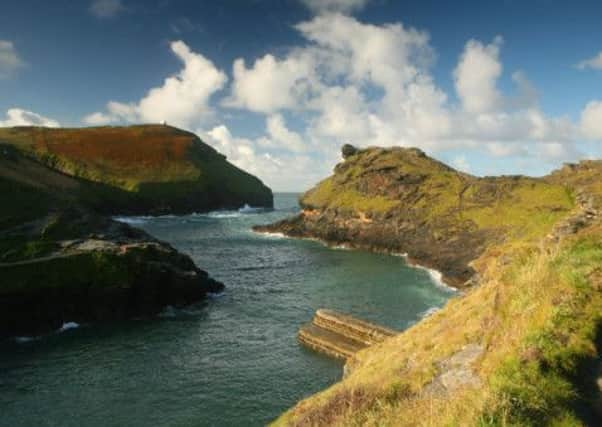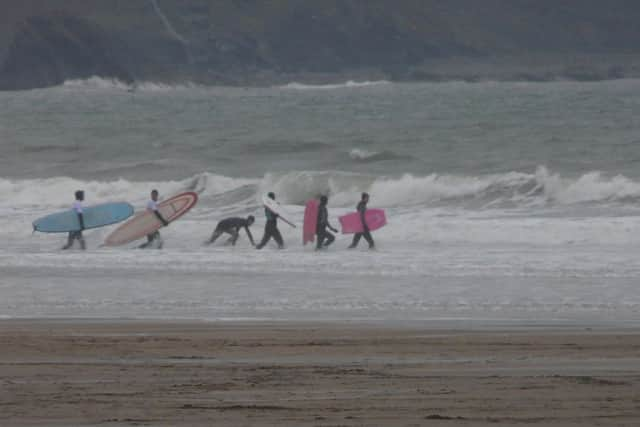Bude vibrations


I do like a good fish pie and what better first supper arriving in Cornwall than Cornish fish pie. You know what proper home-made fish pie tastes like? Well, it was like that. It was waiting for me when I arrived at a de-luxe farmstead on a cold winter’s night in the village of Marhamchurch, near Bude.
I’d have had a snifter first at the pub but, like so many, it has been dark for a year, though some locals are trying to get it back up and running. The next night we ate at Elements (www.elements-life.co.uk), on a headland south of Bude. It was a decent if not outstanding meal suiting the glam and clamour set. Rather more sedate was the baker’s dozen of Spaniards, there for months installing solar panel banks in the fields, something of a Spanish speciality
Advertisement
Hide AdAdvertisement
Hide AdSir Goldsworthy Gurney was inadvertently responsible for Bude’s emergence as a resort. Born near Padstow, Gurney was a surgeon, inventor, scientist – and became wealthy. He leased land in the dunes and on pioneering foundations of a concrete base built his gentleman’s castle in the 1830s. He lit it with an oxygen and hydrogen jet, reflected with mirrors and prisms into the corridors and rooms. A similar system, the Bude Light, aka limelight, was used in Parliament and theatres, light houses and various public places. It’s a long story, displayed in a museum at his former home.


Bude is a bit like this – hooking the newcomer with its little-known claims to fame. The cliffs are the only ones in Cornwall that are made of carboniferous sandstone, more of which later.
What Bude does have is beaches and the Atlantic waves are good enough to attract top surfers. One of the popular ones is Widemouth Bay a few miles from Bude. I’m leaving surfing for my next lifetime. Not cycling though, and pedalling a rental Raleigh from Bude Bikes (www.budebikehire.co.uk) I followed a safe and undemanding trail through bullrushes into the fields. I also rediscovered horse riding, at stables in Gooseham Barton (www.gooseham-barton.com), astride a placid 16-hander called Rory, through old lanes of thorn and thicket. Keener riders can board in the hamlet, owned by Debbie Hamilton who runs the stables.
Resorts need transport and Bude once had both a railway and a canal – which was tidal and ended in lock gates on the beach. The canal joins Summerleaze beach alongside the mouth of the River Neet where there is a natural swimming pool refreshed by the tides. This is now paid for by the town and constantly needs labour and funds. The railway line opened in 1898 and closed in 1966 leaving Bude with the distinction of being further from the rail network than any town in England or Wales. You’ll need a car, bike, bus, or coach from other stations.
Advertisement
Hide AdAdvertisement
Hide AdBude is, however, on the 630-mile coastal path from Minehead in Somerset to Poole, in Dorset. A couple of hours with Dr Roger Higgs, a geologist whose doctorate from Oxford is on the Bude Formation of rocks, will fill you in. His rocky story starts 300m years ago. I learnt how to tell sedimentary rock like limestone from an igneous rock (granite) from metamorphic rock (slate). He leads twice-weekly guided walks around the beach and cliffs used by the US Rangers to train for the cliff assaults on D-Day in 1944 in Normandy.
In these same cliffs you’ll learn how the Bude mud lake folded and compressed long ago. A magnifying glass shows scraps of fossilised marine life. Apparently meaningless fissures are where worms moved through the settling matter. The rarest find was made in the 1930s, a fossilised fish found nowhere else and only in one secret rock bed in Bude. Cornuboniscus Budensis was a few inches long with sharp teeth for eating crab.
Then it was time for lunch at Rosie’s, Kitchen (www.rosieskitchen.co.uk), named for their daughter by Tom and Lisa Dawe. Tom studied events management at Leeds Met and when they settled down with young Rosie after a life on the road, catering and running yurts at festivals, they chose Bude.
For some historic musing head south of Bude to a hidden treasure, the Gildhouse at Poundstock (www.poundstockgildhouse.co.uk). The 16th-century church house was dilapidated when a small group of parishioners won a Heritage Lottery grant towards its £400,000 restoration.
Advertisement
Hide AdAdvertisement
Hide AdTimbers were dated by experts at Sheffield University and the architect did such a good job that it won a major EU prize for cultural heritage from Europa Nostra in 2012.
Getting there
Frederic Manby was a guest of Visit Bude at the family-run Wooldown Holiday Cottages, converted by the Blewett family. The self-catering cottages are built and equipped to a high standard – oak, spa bath, underfloor heating, Jamie’s cutlery, quality hi-fi and electrical appliances, Denby crockery The cost of the four-night stay sleeping two in November was £296. Ready-made meals (the excellent fish pie), food deliveries (including organic) and holistic treatments are available. www.wooldown.com and 01288 361 216.
Details of all the above and more, including Elements popular sea-view restaurant, can be found at www.visitbude.info and 01288 354240.